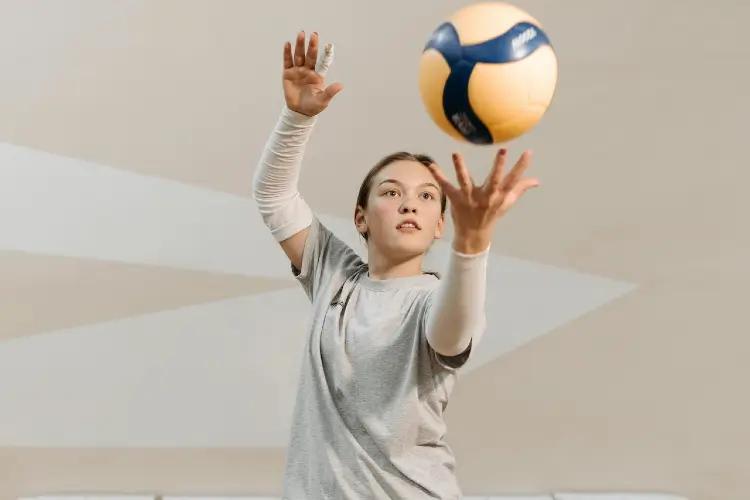Last Updated: October 19, 2023
Volleyball is a thrilling sport that many people love. Though playing volleyball may seem easy, it needs total concentration and good serve techniques to get a score.
Don’t worry if you are new to this game, in this article I will analyse tips for beginners to improve their volleyball serve.
One thing to remember – getting a comfortable grip on the ball is essential when serving. Hold the ball in your dominant hand and ensure your fingers spread out. Next, toss the ball in the air; you can also spin it to confuse your opponents by keeping it in the air for longer. Lastly, hit the ball while following through with the arm to give the serve more power.
A tough serve makes it hard for an opponent to perform an offense. This gives room for free ball outcomes, improving your team’s confidence. You can start with the underhand serve since it’s the easiest, and with time, you can try the overhead and jump serves to get more experience.
Volleyball Serving Tips for Beginners

Since rally scoring is used when counting points, you aim to serve the ball above the net but still ensure it falls inside your opponent’s court. This gives your team an upper hand in the rally and limits the chances of losing points.
As a volleyball player, you should exert these rules to achieve a playable serve.
1. Exercise Hand Contact
It would be great to incorporate science and art to make a volleyball serve. It would help if you changed the ball’s spin, speed, and trail to make a good serve. A good grip over the ball helps you retain hand contact through the whole service motion.
When catching the ball, ensure you spread your fingers apart; this makes you feel the ball’s seams between the fingers. Also work on hand-eye control and harmony for increased effectiveness.
2. Make the Right Toss
While a correct toss is vital to make an excellent serve, achieving it is not as easy.
Here are some tips for getting a good toss.
- Use the non-dominant hand
Tossing a ball is more manageable when done with the non-dominant hand. This gives the dominant hand more room for ball contact, thus helping you to get nice speed and accuracy, which are vital for getting the correct target position.
- Use the lifting motion
As you lift the ball in the air, you still need to exert control over it. A smooth lifting motion without a spin is great for a beginner player to achieve a good ball landing position.
Your primary focus should be to get the ball to a suitable height before hitting it. Placing the ball at a lower height allows your opponent to return it quickly, but reaching it will not be accessible when it is too high.
- Hit the ball
While many players may assume that the power for hitting the ball comes from the hand, this is not usually the case. Though the hitting power stems from your body strength, it must be coordinated.
3. Pick the Right Serve
You will encounter different types of serves when learning to play volleyball. These are the underhand, overhand, float, and jump serve. Despite the serve technique you pick, the ball should cross the net to the other side.
Nevertheless, if you serve the ball and it hits the net but still flies over to your opponent’s court, it’s also ok as it’s still a playable ball. But if you serve a ball that hits the net and then bounces back to your court, the serve is not legal and gives your opponent an extra point.
You should be making contact with the ball before you step over or on the end line.
4. Use the Right Footwork
Making the correct stance is great for achieving a proper serve. This enables you to give more power on every hit you make; hitting the ball in your target area is easy.
Limit the movement of your feet when you are serving, but still ensure that you are comfortable. Since more practice is needed to get the proper footwork, you can ask your teammates or coach to help monitor your movements.
5. Make the Right Hit
Not every hit on the ball will make it to land on the right target. But if you want the ball to hit a particular target position accurately, you should hit it in the right place, which is in the center.
But if you need to make a top spin, first grip the top part and let the fingers point downwards when done. However, getting a side spin means you didn’t hit your ball in the center.
6. Load Your Shoulder
Loading the shoulders when serving helps you to produce more hitting power on the ball. You can do this easily by ensuring the width between your feet when standing is wider than the width of your shoulders and knees.
Additionally, position your body forward to feel all the weight on the front foot, then hit the ball.
7. Be Tactical
A serve is important to getting more points for your team. As a player making the serve, you must think of the strategy and consider the target area beforehand. Next quickly identify your opponent’s team member’s weak points or players and work on them.
8. Keep Practicing
If you keep exercising, you will soon become a good volleyball player. You can do serving drills individually or with your teammates to improve your skills. You can also record a video as you play and watch it later to determine if you are on the right path or made a mistake.
When in the actual competion, don’t panic and don’t use techniques used by other team players that you haven’t practiced, as this may be risky. Just repeat what you have learned and practiced; this will help you to be more accurate when serving the ball.
Types of Volleyball Serves
Underhand Serve
This is the easiest serve to learn for any beginner volleyball player, as it allows better ball control. You can easily land the ball in one area on the opponent’s court. On the other hand, an underhand serve is typically the easiest to return and can give your opponent more edge.
Overhand Serve
An overhand serve exerts more power and speed than the underhand serve. The major disadvantage is it proves harder to control and get a good target position on the opponent’s court. Luckily, an overhand serve can be a good scoring point for your team, as it’s usually hard for the opponents to return.
Float Serve
This is actually an overhand serve, though you don’t spin the ball when tossing it. Instead, you use your hard-open hand, like making a high-five to hit the ball. The float serve involves more ball movement, making it challenging for opponents to determine the ultimate target position.
Jump Serve
As a beginner, you need a lot of practice to do a jump serve, since it’s challenging to master. This is because the serve requires a good toss, better jumping skills, and concurrently hitting the ball.
With this serve you get the upper hand because you will be farther and higher than anyone on the court when you contact the ball. Therefore, the ball drops quicker when it crosses the net; this makes it difficult for your opponent to return.
Conclusion
Even experienced volleyball players were once beginners. If you follow and practice the above tips, you will quickly graduate as a player who can deliver a reliable service and surprise your opponents.
While the goal of a serve is to get the ball into the opponent’s court, you should understand that you can miss a serve, and it’s not bad.
Eye contact, right feet positioning, hand contact, and general body movement are determinants for a reliable serve.
As a beginner player, practicing your serving to perfection is vital, as any error gives your opponent an additional point.
